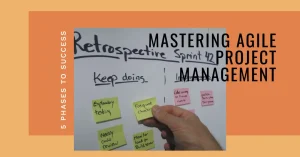To find out how Artificial Intelligence is changing the Project Management landscape, you may enjoy reading this article https://www.shaunstoltz.com/did-artificial-intelligence-just-change-everything-about-project-management/
I. Introduction
Hey there! Are you a project manager or part of a project team? If you’ve ever faced challenges adapting to new situations or handling unexpected changes during a project, you’re not alone. In our fast-paced world, it’s more important than ever to be adaptable and agile. In today’s post, we’re going to explore how effective change management can greatly enhance project management and lead to better outcomes for your projects.
A. Brief overview of change management and project management
Let’s start with the basics. Change management is the process of helping individuals, teams, and organizations transition from their current state to a desired future state. It involves understanding and managing the impact of change on people, processes, and systems. On the other hand, project management is the practice of organizing and guiding teams to achieve specific goals within a set timeframe, often using a structured methodology.
B. The growing need for effective change management in a rapidly changing world
Now more than ever, we’re living in a world of constant change. Technology is advancing rapidly, markets are evolving, and the global landscape is shifting every day. As a project manager or team member, you’ve probably experienced these changes firsthand. New requirements pop up, deadlines are moved, or team members come and go. And let’s face it: change can be tough! That’s where effective change management comes in, helping you and your team adapt and thrive in the face of change.
C. How change management enhances project management
When change is managed well, it can provide a powerful boost to your project management efforts. It ensures that your team is prepared for and can adapt to new circumstances, reducing the likelihood of project delays or failures. Change management can also help minimize the negative impacts of change on stakeholders, ultimately leading to improved project outcomes and increased satisfaction for everyone involved.
So, are you ready to dive in and learn how to harness the power of change management in your project management practice? In the following sections, we’ll delve deeper into the importance of change management, explore its benefits, and provide you with some practical tips on implementing it in your projects. Stay tuned!
II. The Importance of Change Management in Project Management
Now that we’ve laid the groundwork, let’s dive into why change management is such a crucial component of successful project management. Embracing change management can make a world of difference in how smoothly your projects run and how well they achieve their intended goals.
A. Ensuring project success
As a project manager or team member, your ultimate goal is to deliver a successful project. But what does that look like? It might mean meeting deadlines, staying within budget, or ensuring that the final product meets stakeholder expectations. Whatever your definition of success, integrating change management into your project management approach can significantly increase your chances of achieving it. By proactively addressing change, you’ll be better equipped to navigate obstacles, mitigate risks, and ultimately deliver the results your stakeholders expect.
B. Adapting to unforeseen challenges and opportunities
Let’s face it: no project is without its surprises. Sometimes, those surprises are unpleasant – like discovering that a critical resource is no longer available or that a deadline has been moved up. Other times, they’re exciting – like uncovering a new opportunity that could dramatically improve your project’s outcome. Regardless of whether the changes are positive or negative, effective change management ensures that your team can adapt, pivot, and make the most of the situation. And who doesn’t want that kind of flexibility in their projects?
C. Minimizing the negative impacts of change on project stakeholders
Change can be difficult for everyone involved in a project, from team members to clients and other stakeholders. When changes occur, it’s natural for people to feel uncertain or even threatened, which can lead to resistance, disengagement, or even conflict. By incorporating change management strategies into your project management approach, you can help minimize the negative impacts of change on stakeholders. This, in turn, can lead to increased buy-in, improved collaboration, and a more positive project experience for everyone involved.
So now that we’ve seen how important change management is for project management, let’s move on to explore some of the tangible benefits it can bring to your projects. Keep reading to learn more about how change management can give your projects the competitive edge they need!
III. The Benefits of Effective Change Management
Are you ready to supercharge your project management skills? Integrating change management into your projects can yield some fantastic benefits that will not only make your life easier but also impress your stakeholders. Let’s dive into some of these benefits and see how change management can transform your projects for the better.
A. Improved project outcomes
By embracing change management, you’ll be better prepared to tackle the inevitable surprises that come your way during a project. This adaptability means you’re more likely to stay on track, meet your goals, and ultimately deliver a successful project. When you can roll with the punches and adapt to changes as they arise, you’ll find that your projects tend to run smoother and yield better results overall.
B. Better alignment between project goals and organizational objectives
Projects don’t exist in a vacuum. They’re part of a larger organizational ecosystem, and their success is often tied to broader company objectives. Effective change management helps ensure that your project remains aligned with these objectives, even as circumstances evolve. By continually evaluating your project’s progress and adjusting your approach as needed, you can maintain a strong connection between your project goals and the organization’s strategic vision.
C. Enhanced stakeholder engagement and satisfaction
When changes occur in a project, stakeholders can become anxious or resistant if they feel excluded or unprepared. But when you proactively manage change, you can help stakeholders understand the rationale behind the changes and involve them in the decision-making process. This collaborative approach can lead to increased engagement, trust, and satisfaction among stakeholders, making your projects more enjoyable and successful for everyone involved.
D. Increased agility and resilience within project teams
A team that is skilled in change management becomes more agile and resilient in the face of unexpected challenges. When your team is comfortable adapting to new circumstances, they’ll be better equipped to handle curveballs and maintain their momentum. This increased agility can also make your team more attractive to clients, as organizations increasingly seek partners who can adapt and respond to changing market conditions.
E. Streamlined communication and decision-making processes
Change management often involves streamlining communication channels and decision-making processes within your project team. This can lead to more efficient, effective communication and faster decision-making, ultimately resulting in a more nimble and responsive project team. When your team can make decisions quickly and communicate them effectively, you’ll be better positioned to handle the inevitable twists and turns that come with any project.
As you can see, there are numerous benefits to incorporating change management into your project management practice. In the next section, we’ll explore some practical tips for implementing change management in your projects, so you can start reaping these rewards for yourself! Stay tuned!
IV. Implementing Change Management in Project Management
So, you’re convinced of the power of change management and ready to start integrating it into your projects? That’s fantastic! Now, let’s discuss some practical steps you can take to make change management an integral part of your project management practice.
A. Integrating change management into project management methodologies
Whether you’re a fan of Agile, Waterfall, or another project management methodology, the good news is that change management can be incorporated into virtually any approach. The key is to ensure that change management principles are woven into each stage of your project lifecycle, from initiation to closure. This might involve incorporating change-related tasks into your project plans, regularly reviewing and adjusting your approach to address emerging changes, or including change management training as part of your team’s professional development.
B. Employing change management tools and techniques
There are numerous tools and techniques available to help you manage change effectively. Some popular ones include stakeholder analysis (to understand the needs and concerns of those affected by change), risk assessment (to identify and mitigate potential change-related risks), and communication planning (to ensure that change messages are delivered clearly and consistently). By exploring these and other change management techniques, you can build a robust toolkit that will serve you well throughout your projects.
C. Building a change-ready culture within project teams
Creating a culture that embraces change is essential for effective change management. This starts with fostering a mindset that views change as an opportunity rather than a threat. Encourage your team to be open to new ideas, willing to learn, and adaptable in the face of changing circumstances. By promoting a change-ready culture, you’ll build a project team that is not only more resilient but also more innovative and collaborative.
D. Ensuring ongoing change monitoring, evaluation, and adjustment
Change management is not a one-and-done process. It’s essential to monitor, evaluate, and adjust your approach throughout the life of your project. This might involve regularly checking in with stakeholders to gauge their reactions to change, tracking your project’s progress against its goals, or conducting post-project reviews to learn from your experiences and improve your change management practice.
As you work to implement change management in your project management efforts, remember that it’s an ongoing process that requires commitment and flexibility. Be patient with yourself and your team, and don’t be afraid to adjust your approach as needed. The results will be well worth the effort!
In the next section, we’ll look at some real-life examples of successful change management in project management and explore the lessons we can learn from them. Stay tuned for some inspiring case studies!
V. Case Studies: Successful Change Management in Project Management
Nothing is more inspiring than learning from real-life examples of success. In this section, we’ll explore a few case studies of organizations that have effectively managed change in their projects. These examples will demonstrate the power of change management in action and offer valuable lessons and best practices you can apply to your own projects.
A. Example 1: A technology company’s agile transformation
A global technology company faced challenges with its traditional Waterfall project management approach, as it struggled to keep up with rapidly changing market demands. The company decided to transition to an Agile methodology to increase flexibility and responsiveness. Recognizing the significant change this would entail, the organization prioritized change management throughout the transformation.
Leadership engaged in extensive communication efforts to ensure employees understood the rationale behind the shift and the benefits it would bring. They also provided training and coaching to help teams adjust to the new way of working. As a result, the organization successfully transitioned to Agile, experiencing increased efficiency, faster time-to-market, and higher customer satisfaction.
Lesson: Effective communication and training are crucial when implementing significant changes in project management methodologies.
B. Example 2: A healthcare organization’s process improvement project
A healthcare organization embarked on a process improvement project to streamline its patient care delivery. The project required changes in the roles and responsibilities of various team members and the adoption of new technology. The organization recognized the potential for resistance and confusion among employees and prioritized change management to ensure a smooth transition.
The project team conducted a thorough stakeholder analysis to identify concerns and potential resistance, and they developed targeted communication and engagement strategies to address these issues. By involving stakeholders in the decision-making process and providing clear, consistent communication, the organization achieved its process improvement goals and saw a significant increase in employee satisfaction and patient care quality.
Lesson: Stakeholder analysis and engagement are vital when implementing changes that impact roles, responsibilities, and processes.
C. Example 3: A manufacturing company’s merger and acquisition
When a manufacturing company acquired a smaller competitor, the resulting integration of teams, processes, and systems presented numerous challenges. The organization knew that a successful merger would require effective change management to minimize disruption and ensure that the new, combined entity could operate smoothly.
The company conducted a risk assessment to identify and mitigate potential obstacles related to the merger, such as cultural clashes and technology integration issues. They also established clear communication channels and decision-making processes to facilitate collaboration between the merging teams. As a result, the company successfully navigated the complex integration, realizing significant cost savings and growth opportunities.
Lesson: Risk assessment and streamlined communication are key to successfully managing change in complex, high-stakes projects.
These case studies showcase the power of effective change management in project management and offer valuable insights you can apply to your own projects. Remember, change management is not a one-size-fits-all approach – it’s about finding the strategies and techniques that work best for your unique situation and adapting them as needed to ensure project success.
In the next section, we’ll wrap up our discussion and provide some final thoughts on the importance of change management in project management. Keep reading for some closing words of wisdom!
VI. Conclusion
As we come to the end of our exploration of the power of effective change management in project management, let’s take a moment to recap what we’ve learned and offer some encouragement for your journey ahead.
A. Recap of the importance of change management in project management
Throughout this blog post, we’ve seen how change management can play a critical role in ensuring project success. By proactively addressing change, your team will be better equipped to navigate obstacles, mitigate risks, and ultimately deliver the results your stakeholders expect. We’ve also discussed the many benefits of effective change management, such as improved project outcomes, better alignment with organizational objectives, and enhanced stakeholder satisfaction.
B. Encouraging organizations to prioritize and invest in effective change management strategies
If there’s one takeaway from this post, it’s that change management should not be an afterthought or a “nice-to-have” in your project management practice. Instead, it should be a priority and a core competency for your team. By investing in change management – through training, tools, and techniques – you’ll set your projects up for success and build a more agile, resilient, and competitive organization.
So, what are you waiting for? It’s time to embrace change management as an integral part of your project management toolkit. No matter the size, scope, or complexity of your projects, change management can help you and your team adapt, thrive, and deliver exceptional results. Remember, change is inevitable – but with the right approach and mindset, you can turn it into an opportunity for growth and success.
Thank you for joining us on this journey through the power of effective change management in project management. We hope you’ve found the insights, tips, and case studies we’ve shared to be valuable and inspiring. Now go forth and harness the power of change to make your projects more successful than ever before!
Find out more about Shaun Stoltz https://www.shaunstoltz.com/about/
This post was written by an AI and reviewed/edited by a human.



